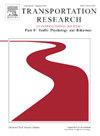系统回顾和荟萃分析从SAE 2级和3级自动驾驶到手动控制的接管时间
IF 3.5
2区 工程技术
Q1 PSYCHOLOGY, APPLIED
Transportation Research Part F-Traffic Psychology and Behaviour
Pub Date : 2025-05-12
DOI:10.1016/j.trf.2025.04.003
引用次数: 0
摘要
道路运输自动化程度的提高保证了安全的显著改善。然而,SAE 2级和3级从自动到手动控制的过渡带来了严峻的安全挑战,特别是在接管请求(TORs)期间。了解接管时间(TOT)的影响因素对于确保驾驶员有效和安全的响应至关重要,特别是在不同的道路、交通和人机界面(HMI)条件下。本研究系统地调查了道路环境、交通量、SAE级别、HMI设计和TOR警报如何影响TOT。它还研究了TOT如何影响驾驶性能和安全指标,如加速、车道位置和事故发生率。使用PRISMA框架,系统地回顾了51项研究。采用meta回归和敏感性分析量化关键因素对TOT的影响。平视显示器(- 14.8%)、TOR警报(- 64.7%)和更高的交通量(从自由流量到高交通量每增加10.8%)与较短的TOT相关,而紧急TOR(+ 36.7%)、不平等性别分布(+ 14.3%)、增加的时间预算(每秒+ 1.8%)和额外的车道(每车道+ 14.2%)与较长的TOT相关。不同道路类型和交通量的TOT差异很大,高速公路的TOT较长,高交通量导致TOT较短,这可能是由于驾驶员注意力的提高。驾驶性能指标显示,较短的TOT与较高的最大纵向和横向加速度、较大的车道可变性以及适度增加的碰撞率之间存在显著相关性,这凸显了潜在的安全问题。这项研究强调了针对特定驾驶环境、道路状况和自动化水平量身定制的自适应系统的关键作用。本文章由计算机程序翻译,如有差异,请以英文原文为准。
Systematic review and meta-analysis of take-over time from automated driving at SAE levels 2 and 3 to manual control
The increasing automation of road transport promises significant safety improvements. However, the transition from automated to manual control at SAE Levels 2 and 3 poses critical safety challenges, particularly during Take-Over Requests (TORs). Understanding the factors influencing Take-Over Time (TOT) is crucial for ensuring effective and safe driver responses, especially under varying road, traffic, and Human-Machine Interface (HMI) conditions. This study systematically investigates how TOT is affected by road environments, traffic volumes, SAE levels, HMI designs, and TOR alerts. It also examines how TOT influences driving performance and safety metrics, such as, acceleration, lane position, and crash rates after TOR. Using the PRISMA framework, 51 studies were systematically reviewed. Meta-regression and sensitivity analyses were conducted to quantify the effects of key factors on TOT. Heads-Up Displays (–14.8 %), TOR alerts (–64.7 %), and higher traffic volumes (–10.8 % per increase from free flow to high traffic volume) were associated with shorter TOT, while urgent TORs (+36.7 %), unequal gender distribution (+14.3 %), increased time budgets (+1.8 % per second), and additional lanes (+14.2 % per lane) were associated with longer TOT. TOT varied significantly across road types and traffic volumes, with highways exhibiting longer TOT and high traffic volumes resulting in shorter TOT, likely due to heightened driver attentiveness. Driving performance metrics revealed significant correlations between shorter TOT and higher maximum longitudinal and lateral accelerations, greater lane variability, and a moderate increase in crash rates, highlighting potential safety concerns. This study highlights the critical role of adaptive systems tailored to specific driving contexts, road conditions, and automation levels.
求助全文
通过发布文献求助,成功后即可免费获取论文全文。
去求助
来源期刊
CiteScore
7.60
自引率
14.60%
发文量
239
审稿时长
71 days
期刊介绍:
Transportation Research Part F: Traffic Psychology and Behaviour focuses on the behavioural and psychological aspects of traffic and transport. The aim of the journal is to enhance theory development, improve the quality of empirical studies and to stimulate the application of research findings in practice. TRF provides a focus and a means of communication for the considerable amount of research activities that are now being carried out in this field. The journal provides a forum for transportation researchers, psychologists, ergonomists, engineers and policy-makers with an interest in traffic and transport psychology.

 求助内容:
求助内容: 应助结果提醒方式:
应助结果提醒方式:


